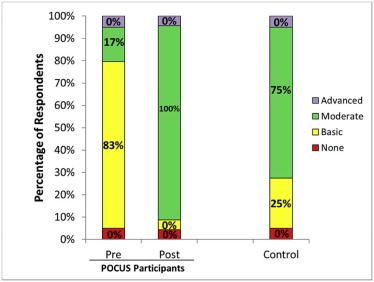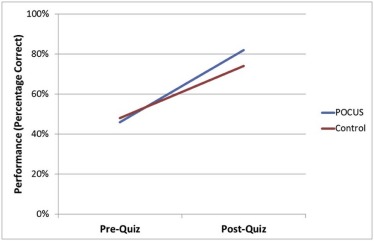Rationale and Objectives
We aimed to assess the impact of our institution’s recently created point-of-care ultrasound (POCUS) course for preclinical medical students by examining its effect on first–year-level medical knowledge, self-reported skill level, and beliefs regarding the importance of ultrasound in future clinical practice.
Materials and Methods
A total of 18 first-year medical students completed a 5-month near–peer-led training program in POCUS consisting of 3-hour teaching sessions (7), 4-hour clinical sessions (10–12), and an independent study. Students completed pre- and postprogram assessments examining (1) student perceptions about ultrasound and its importance to future careers, (2) students’ self-reported skill level with ultrasound, and (3) performance on an anatomy and physiology knowledge quiz. Scores and responses were compared to 20 controls.
Results
The majority of students believed that ultrasound was useful for learning anatomy and would be important in their future clinical practice. Students who completed our training program tended to perform better than controls on a test of medical knowledge. Despite reporting far fewer hours of formal ultrasound training, control students rated their skill level comparably to POCUS-trained students.
Conclusions
This study provides evidence that ultrasound is well received by medical students and may be useful for teaching basic anatomy concepts.
Introduction
The increasing portability and affordability of ultrasound technology has allowed physicians from a wide range of fields to adopt its uses at the bedside. As point-of-care ultrasound (POCUS) expands both in clinical practice and in residency training programs in emergency medicine, anesthesiology, obstetrics and gynecology , and more, there is an increasing interest in teaching basic ultrasound skills to medical students at the earliest stages of training. However, as the popularity of medical student ultrasound education grows, it is important that institutions offering this training continually assess the utility and impact of their programs. Potential concerns include the observation that student-reported benefit of ultrasound as an anatomy learning tool has been shown to be greater than the actual measured improvement in anatomical knowledge , as well as the question of whether students with almost no clinical training can appreciate the nuances of this complex clinical tool . Nonetheless, several U.S. medical schools that have already developed well-integrated, longitudinal programs generally report a high degree of student satisfaction and excellent performance on assessments of basic skills . To assess the impact of our own recently created elective in POCUS, we undertook the following study.
In the summer of 2014, eight second-year medical students at our institution designed and implemented a faculty-supervised, near–peer-taught ultrasound course for first-year medical students that consisted of seven educational classes, an independent study using course materials, and additional clinical sessions. The primary objectives of this course were to provide training in basic ultrasound skills via a self-sustaining, near-peer education model; to reinforce the anatomy and physiology being taught concurrently in the first-year curriculum; and to instill in students an appreciation for the complexities of POCUS in clinical practice. The design and content of the course were based on programs at other institutions . A near-peer education model was adopted as it has been shown to benefit the learner and the teacher and because of the limited availability of faculty instructors, a common obstacle also encountered at other programs .
Get Radiology Tree app to read full this article<
Materials and Methods
Ethical Approval
Get Radiology Tree app to read full this article<
Study Design and Population
Get Radiology Tree app to read full this article<
Get Radiology Tree app to read full this article<
Intervention
Get Radiology Tree app to read full this article<
Get Radiology Tree app to read full this article<
Get Radiology Tree app to read full this article<
Get Radiology Tree app to read full this article<
Get Radiology Tree app to read full this article<
Get Radiology Tree app to read full this article<
Control Group Experience
Get Radiology Tree app to read full this article<
Measures
Get Radiology Tree app to read full this article<
Table 1
Knowledge Quiz
1. Where is the Morison pouch?
Classification: Anatomy 8. The common femoral vein is derived from which two vessels?
Classification: Anatomy 2. Which of the following are retroperitoneal?
Classification: Anatomy 9. In the popliteal fossa, which vessel is most posterior?
Classification: Anatomy 3. The hepatic veins empty into the __________.
Classification: Anatomy 10. When a person is in the upright position, where is the fluid in a pleural effusion?
Classification: Pathology 4. Which vessels are the most affected by volume depletion (ie, most compliant)?
Classification: Physiology 11. Hydronephrosis would most typically be seen in which of the following pathologies?
Classification: Pathology 5. In general, what is the relationship of the carotid artery to the internal jugular vein?
Classification: Anatomy 12. Where are the ureterovesical junctions located?
Classification: Anatomy 6. Which is a normal central venous pressure?
Classification: Physiology 13. What is the first duct into which the gallbladder empties?
Classification: Anatomy 7. What is the anteriormost chamber of the heart?
Classification: Anatomy 14. In its advanced stages, what would happen to the size of the liver in a patient with cirrhosis?
Classification: Pathology
Answer counted as correct is shown in bold. Classification as either an anatomy question, a physiology question, or a pathology question is shown in italic.
Get Radiology Tree app to read full this article<
Get Radiology Tree app to read full this article<
Table 2
Perceptions Survey
1. How much formal training (lectures, didactics, dedicated hands-on training) have you had in ultrasound to date?
4. Do you think ultrasound would be beneficial in helping you retain the basic anatomy learned during the first year of medical school?
2) What is your skill level in ultrasound?
5. Do you feel confident teaching ultrasound to your fellow classmates?
3. Do you envision point-of-care ultrasound to be an important clinical skill in your professional career?
Get Radiology Tree app to read full this article<
Get Radiology Tree app to read full this article<
Get Radiology Tree app to read full this article<
Data Analysis
Get Radiology Tree app to read full this article<
Results
Elective’s Impact on Student Perceptions About POCUS in Medical Training and Future Practice
Get Radiology Tree app to read full this article<
Get Radiology Tree app to read full this article<
Importance of the Ultrasound to Future Career
Get Radiology Tree app to read full this article<
Relevance of Ultrasound in Learning Anatomy
Get Radiology Tree app to read full this article<
Confidence Teaching Ultrasound
Get Radiology Tree app to read full this article<
Self-ratings of Ultrasound Skill Level
Get Radiology Tree app to read full this article<
Get Radiology Tree app to read full this article<
Get Radiology Tree app to read full this article<
Get Radiology Tree app to read full this article<
Get Radiology Tree app to read full this article<
Performance of POCUS Elective vs Control Students on Knowledge Quiz Pre- and Post Program
Get Radiology Tree app to read full this article<
Get Radiology Tree app to read full this article<
Get Radiology Tree app to read full this article<
Discussion
Get Radiology Tree app to read full this article<
Get Radiology Tree app to read full this article<
Get Radiology Tree app to read full this article<
Get Radiology Tree app to read full this article<
Get Radiology Tree app to read full this article<
Get Radiology Tree app to read full this article<
Get Radiology Tree app to read full this article<
Acknowledgments
Get Radiology Tree app to read full this article<
Get Radiology Tree app to read full this article<
References
1. The anesthesiology milestone project. 2014; 6: pp. 15-28.
2. ACR–SPR–SRU Practice Parameter for performing and interpreting diagnostic ultrasound examinations. 2014.
3. Ahern M., Mallin M.P., Weitzel S., et. al.: Variability in ultrasound education among emergency medicine residencies. 2010; 11: pp. 314-318.
4. Sweetman G.M., Crawford G., Hird K., et. al.: The benefits and limitations of using ultrasonography to supplement anatomical understanding. Anat Sci Educ 2013; 6: pp. 141-148.
5. Webb E.M., Cotton J.B., Kane K., et. al.: Teaching point of care ultrasound skills in medical school: keeping radiology in the driver’s seat. Acad Radiol 2014; 21: pp. 893-901.
6. Rao S., van Holsbeeck L., Musial J.L., et. al.: A pilot study of comprehensive ultrasound education at the Wayne State University School of Medicine: a pioneer year review. J Ultrasound Med 2008; 27: pp. 745-749.
7. Fox J.C., Schlang J.R., Maldonado G., et. al.: Proactive medicine: the “UCI 30,” an ultrasound-based clinical initiative from the University of California, Irvine. Acad Med J Assoc Am Med Coll 2014; 89: pp. 984-989.
8. Hoppmann R.A., Rao V.V., Poston M.B., et. al.: An integrated ultrasound curriculum (iUSC) for medical students: 4-year experience. Crit Ultrasound J 2011; 3: pp. 1-12.
9. Brown B., Adhikari S., Marx J., et. al.: Introduction of ultrasound into gross anatomy curriculum: perceptions of medical students. J Emerg Med 2012; 43: pp. 1098-1102.
10. Swamy M., Searle R.F.: Anatomy teaching with portable ultrasound to medical students. BMC Med Educ 2012; 12: pp. 99.
11. Tshibwabwa E.T., Groves H.M.: Integration of ultrasound in the education programme in anatomy. Med Educ 2005; 39: pp. 1148.
12. Evans D.J.R., Cuffe T.: Near-peer teaching in anatomy: an approach for deeper learning. Anat Sci Educ 2009; 2: pp. 227-233.
13. Naeger D.M., Conrad M., Nguyen J., et. al.: Students teaching students: evaluation of a “near-peer” teaching experience. Acad Radiol 2013; 20: pp. 1177-1182.
14. Youdas J.W., Hoffarth B.L., Kohlwey S.R., et. al.: Peer teaching among physical therapy students during human gross anatomy: perceptions of peer teachers and students. Anat Sci Educ 2008; 1: pp. 199-206.
15. Nelson A.J., Nelson S.V., Linn A.M.J., et. al.: Tomorrow’s educators … today? Implementing near-peer teaching for medical students. Med Teach 2013; 35: pp. 156-159.
16. Bahner D.P., Adkins E.J., Hughes D., et. al.: Integrated medical school ultrasound: development of an ultrasound vertical curriculum. Crit Ultrasound J 2013; 5: pp. 6.
17. Chiem A.T., Soucy Z., Dinh V.A., et. al.: Integration of ultrasound in undergraduate medical education at the California Medical Schools: a discussion of common challenges and strategies from the UMeCali experience. J Ultrasound Med 2016; 35: pp. 221-233.
18. Dinh V.A., Lakoff D., Hess J., et. al.: Medical student core clinical ultrasound milestones: a consensus among directors in the United States. J Ultrasound Med 2016; 35: pp. 421-434.
19. Baltarowich O.H., Di Salvo D.N., Scoutt L.M., et. al.: National ultrasound curriculum for medical students. Ultrasound Q 2014; 30: pp. 13-19.
20. Wittich C.M., Montgomery S.C., Neben M.A., et. al.: Teaching cardiovascular anatomy to medical students by using a handheld ultrasound device. JAMA 2002; 288: pp. 1062-1063.
21. Gradl-Dietsch G., Korden T., Modabber A., et. al.: Multidimensional approach to teaching anatomy-Do gender and learning style matter?. Ann Anat 2016;
22. Hammoudi N., Arangalage D., Boubrit L., et. al.: Ultrasound-based teaching of cardiac anatomy and physiology to undergraduate medical students. 2013; 106: pp. 487-491.
23. Smith C.F., Mathias H.S.: What impact does anatomy education have on clinical practice?. Clin Anat 2011; 24: pp. 113-119.


